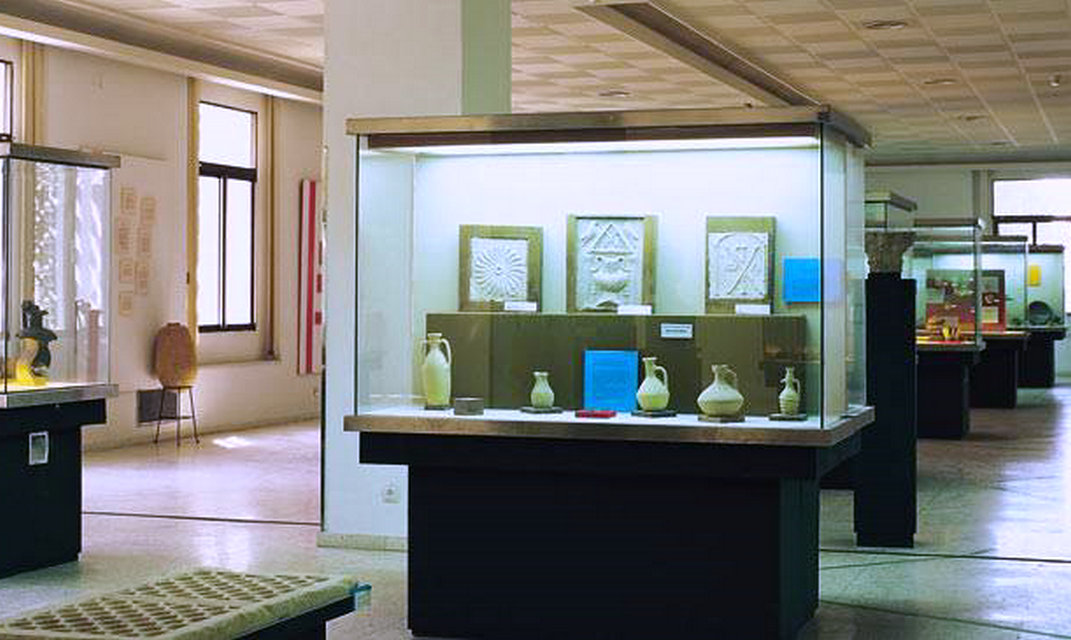The Huelva Museum, formerly called the Provincial Museum of Huelva, is an institution whose headquarters is in the Alameda Sundheim of the city of Huelva (Spain) in a building, inaugurated on October 12, 1973, with 3000 m² and divided in Three floors, basement and small garden area. Its endowment is broad, subdividing itself in three sections: the one of fine arts or pinacoteca, the one of archeology and the one of ethnology. The Museum of Huelva is dependent of the Junta de Andalucía.
The Huelva Museum, formerly called the Provincial Museum of Huelva, is an institution whose headquarters are in the Alameda Sundheim of the city of Huelva (Spain) in a building, inaugurated on October 12, 1973, with 3000 m² and divided into Three floors, basement and small garden area. Its endowment is broad, subdividing itself in three sections: the one of fine arts or pinacoteca, the one of archeology and the one of ethnology. The Museum of Huelva is dependent of the Junta de Andalucía.
At the beginning of century XX, a group of citizens of Huelva had created the so-called Provincial Museum of fine arts that finally was managed by the Spanish State from 1922. To the works of art (some private) was added an archaeological section commanded by Carlos Cerdán Márquez on the grounds of the gas factory of the city’s port. The increase in funding allowed the State, from 1970, to be careful to designate a museum curator (D. Mariano del Amo) in Huelva and inaugurate a building that would bring together all the pieces.
The current Museum of Huelva is formed by a new building, with a useful surface area of 3,000 m² divided into three floors and a lower-ground floor. Its contents were structured in two sections: Archaeology and Fine Arts.
The Archaeological Section was set up on a surface area of approximately 950 m², supported by the rich historic past of the province, among the collections, the elements from the dolmen complex of La Zarcita and El Pozuelo, the rich funerary pieces under Eastern influence in the necropolis of La Joya, the materials of Phoenician and Greek origin, documented in the urban excavations of the city, and the ceramic and metallic objects which verify the high level of development achieved by the Tartessus culture through the mining-metallurgic practices of the mines from Huelva, with important sites such as Tejada la Vieja (Escacena del Campo) or Niebla.
With a space of 650 m² in four rooms plus deposit area. The endowment is essentially pictorial from museums such as the Museum of Fine Arts in Seville, the Spanish Museum of Contemporary Art in Madrid (now the Reina Sofía Museum) and private donations. They emphasize different works of contemporary painters such as Mateo Orduña Castellano, Granado Valdés, José Caballero, José María Labrador or Sebastián García Vázquez, students of the School of fine arts of the city of which Eugenio Hermoso was director, or artists like José Alcoverro. In the future the space will be reconverted in the section titled “The art of Huelva in Century XX”.
But the central axis of the pictorial collection, since 1973, is the exhibition of paintings by nervense Daniel Vázquez Díaz, artist of the 20th century who drew the murals on the discovery and Christopher Columbus in the Monastery of Rábida. Among his paintings is the cubist portrait influenced by his friend, the poet Juan Ramón Jiménez de Moguer, “The death of a bullfighter” or “Adriano del Valle dressed as a monk Mercedarian.”
The section occupies over 900 m² divided into an exhibition hall and a warehouse. The passage of ancient cultures through the area of the province of Huelva, the estuary, the Island of Saltés and the present urban nucleus have allowed the creation of an interesting exhibition of objects. Highlights are objects from El Pozuelo, Santa Barbara and the extinct head of La Joya in the capital ordered chronologically until the Middle Ages.
Interesting are some Phoenician and Greek artifacts and objects of Roman origin found in mining operations in the province, such as the reconstruction of a hydraulic wheel of more than four meters and unique in Spain from original elements. It was found in 1928 in the town of Minas de Riotinto.
Of Arab epoch, and coming from the capital, they emphasize a caliphal capital of marble, a mozárabe bell of bronze and a Málaga stelae of metallic reflections.
The collection of mining materials from Riotinto during the Roman period is of particular interest, with unique pieces such as the hydraulic wheel exhibited in the entrance hall of the museum.
Covering a surface area of approximately 650 m², the Fine Arts section is divided into four exhibition halls. Daniel Vázquez Diaz is one of the most important painters of Huelva. We should make mention to the group of charcoal portraits of intellectuals of the time or the work”Muerte de un torero” (Death of a bullfighter), in which, in addition to showing all his talent in plastic arts, the painter paid homage to his native town depicting some of his fellow countrymen in the canvas.
It’s also noteworthy the work gathered in the history of plastic arts from Huelva, from the students of the old School of Fine Arts at the beginning of the 20th century to present. Noteworthy works include those by José Caballero, recently acquired by the Junta de Andalucía, or donations by local artists such as Mateo Orduña Castellanos, Granado Valdés, Castro Crespo, José María Franco or Juan Manuel Vidal among others.
